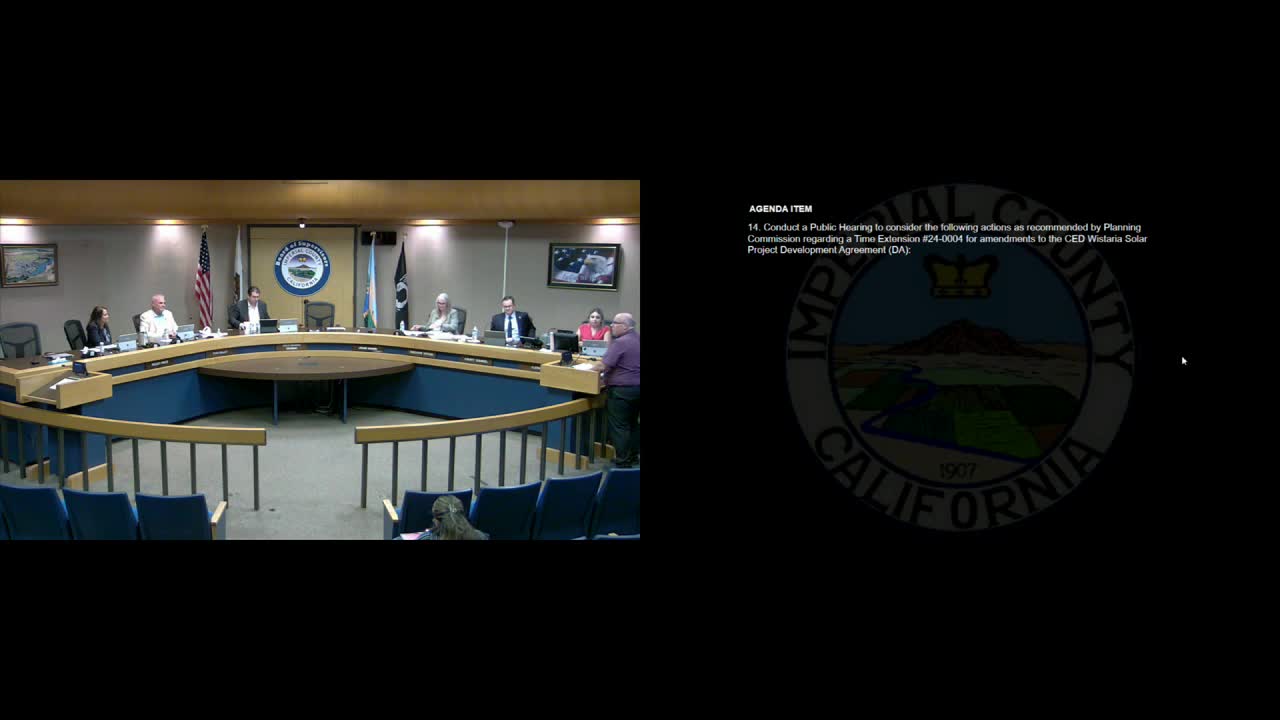Imperial County Supervisors Approve Wisteria Ranch Solar Project Agreement Extension
August 19, 2025 | Imperial County, California
This article was created by AI summarizing key points discussed. AI makes mistakes, so for full details and context, please refer to the video of the full meeting. Please report any errors so we can fix them. Report an error »

In a pivotal meeting held on August 19, 2025, the Imperial County Board of Supervisors deliberated on a request from Wisteria Ranch Solar Development to extend and amend its development agreement. The proposal aims to extend the life of 11 conditional use permits (CUPs) for an additional ten years, allowing the developer to continue operations on approximately 1,600 acres of land located southwest of Calexico.
The discussion began with a presentation highlighting the existing solar projects, which cover about 973 acres, and the potential for future development. The board noted that the extension would not alter land use entitlements but would allow for minor financial adjustments. The developer has already constructed five of the original sixteen CUPs over the past decade.
Public comments revealed a deep divide in community sentiment. Valeria Mejia, a local resident and biologist, voiced strong opposition to the extension, citing concerns over agricultural land loss and environmental impacts. She pointed out that over 13,000 acres of farmland have been lost to solar development since the original agreement was approved in 2014. Mejia emphasized the importance of preserving agricultural resources and expressed frustration over the lack of maintenance at existing solar sites, which she argued has led to increased wildlife encounters and other local issues.
In contrast, Christina Gispert, representing RWE, the current developer, expressed gratitude for the board's support and highlighted the company's commitment to maintaining the site. She addressed concerns about site management, stating that the facility is well-maintained and operates efficiently.
Walter Holtz, another local resident, supported the extension, arguing that the land in question is marginal for agriculture and that solar development could be beneficial for the community.
After hearing from the public, the board moved to approve the extension and amendments to the development agreement, passing the motions with a 3-0 vote. The supervisors acknowledged the need for ongoing discussions about the balance between solar development and agricultural preservation, indicating that this issue will remain a focal point in future meetings.
As Imperial County navigates the complexities of renewable energy development, the board's decision reflects the ongoing tension between advancing green energy initiatives and protecting vital agricultural land. The implications of this decision will likely resonate throughout the community as stakeholders continue to advocate for their interests in the evolving landscape of energy and agriculture.
The discussion began with a presentation highlighting the existing solar projects, which cover about 973 acres, and the potential for future development. The board noted that the extension would not alter land use entitlements but would allow for minor financial adjustments. The developer has already constructed five of the original sixteen CUPs over the past decade.
Public comments revealed a deep divide in community sentiment. Valeria Mejia, a local resident and biologist, voiced strong opposition to the extension, citing concerns over agricultural land loss and environmental impacts. She pointed out that over 13,000 acres of farmland have been lost to solar development since the original agreement was approved in 2014. Mejia emphasized the importance of preserving agricultural resources and expressed frustration over the lack of maintenance at existing solar sites, which she argued has led to increased wildlife encounters and other local issues.
In contrast, Christina Gispert, representing RWE, the current developer, expressed gratitude for the board's support and highlighted the company's commitment to maintaining the site. She addressed concerns about site management, stating that the facility is well-maintained and operates efficiently.
Walter Holtz, another local resident, supported the extension, arguing that the land in question is marginal for agriculture and that solar development could be beneficial for the community.
After hearing from the public, the board moved to approve the extension and amendments to the development agreement, passing the motions with a 3-0 vote. The supervisors acknowledged the need for ongoing discussions about the balance between solar development and agricultural preservation, indicating that this issue will remain a focal point in future meetings.
As Imperial County navigates the complexities of renewable energy development, the board's decision reflects the ongoing tension between advancing green energy initiatives and protecting vital agricultural land. The implications of this decision will likely resonate throughout the community as stakeholders continue to advocate for their interests in the evolving landscape of energy and agriculture.
View full meeting
This article is based on a recent meeting—watch the full video and explore the complete transcript for deeper insights into the discussion.
View full meeting
